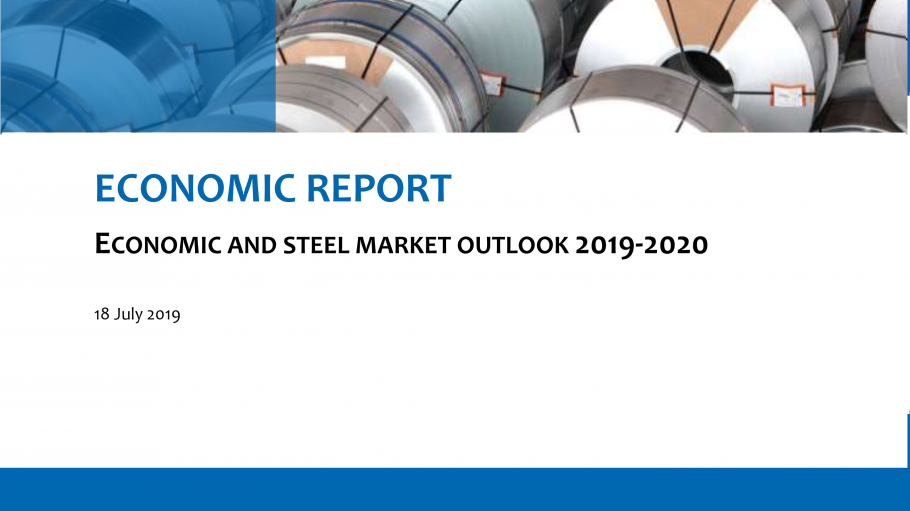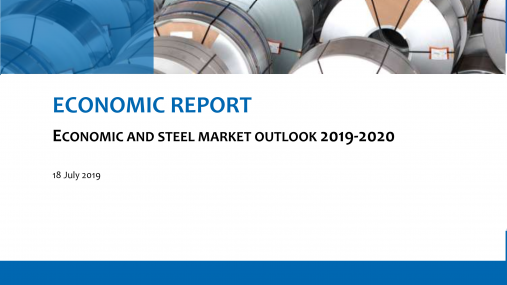
Press releases » First data for 2019 confirm slump in steel demand on the back of manufacturing weakness
First data for 2019 confirm slump in steel demand on the back of manufacturing weakness
Downloads and links
Recent updates

Brussels, 18 July 2019 – Apparent steel consumption fell by 2.5% year-on-year in the first quarter of 2019. The negative trend in steel demand is the result of the ongoing slump in EU’s manufacturing sector due to weakened exports and investment. Forward-looking indicators signal, at best, a low-level stabilisation later this year, but no rebound.
The manufacturing sector in the EU may have not seen the worst yet: a deepening escalation of the trade war between the US and several of its main trading partners and a no-deal Brexit would severely impact global trade conditions, trigger a further deterioration in business sentiment and lower investment growth. In that scenario, the EU steel sector would suffer badly because at the same time the risk of import distortions increases due to the expansion of the size of the safeguard measures’ quota both this year and next.
“Given these economic and market conditions the European Commission needs to act now to adapt the steel safeguard measures to reflect these circumstances”, said Axel Eggert, Director General of the European Steel Association (EUROFER). “The repeated rises in the size of the quota this year and next are completely out of step with the sluggish steel market”.
EU steel market overview
EU28 apparent steel consumption fell by 2.5% year-on-year in the first quarter of 2019 and amounted to 42.6 million tonnes. Stock building in the distribution chain was lower than in the same quarter of 2018, which exacerbated the negative trend in final steel use. This should be seen in context of the development of the inventory cycle in the second half of last year which was characterised by lower than usual seasonal inventory reductions and therefore relatively high stock levels in the EU steel distribution chain at the start of 2019
The negative trend in steel demand at the start of this year has primarily hurt domestic steel producers in the EU. In the first quarter of 2019 domestic deliveries from EU mills to the EU market fell by 4% compared with the same period of 2018. Meanwhile, third country imports decreased only by 1% year-on-year and amounted to 10 million tonnes, accounting for 23.6% of EU steel demand.
The overall trend in total imports hides distortive developments in imports at the individual product level which are allowed under the current quota modalities and management. This situation has created, for several products, a rush for quota consumption including stock building and import concentration, disrupting the stagnating EU steel market, notably by Turkey and China. The most affected products are metallic coated sheets for automotive applications, rebar and wire rod.
The EU steel market is facing severe challenges which are expected to have a negative impact on apparent steel consumption. Following a decline in the first quarter of 2019, real steel consumption is, on balance, expected to stabilise around the year earlier level in the remainder of the year, leading to a total reduction in final steel use by 0.4% over the whole year. Meanwhile, flaws in the design and functioning of the current safeguard measures do not reflect the reality of an EU steel market. The market is being squeezed between negative final steel use developments and is facing the ongoing and serious threat of import deflection triggered by the US Section 232 import tariff in a context of persistent global overcapacity. The system still allows for extreme behaviours by exporters which have the potential to lead to serious market distortions. The expected reduction of apparent steel consumption in 2019 of 0.6% year-on-year is therefore expected to come mainly at the expense of EU steel producers.
Even though market conditions in 2020 are expected to improve moderately, risks related to import distortions continue to threaten the stability of the EU steel market. The 5% increase in the safeguard quota from July 2020 – following a 5% rise in February and in July 2019 – is once more not aligned with expected growth in real steel consumption of just 1.1% in 2020. The EU market therefore remains at risk of being destabilised by third country imports at the expense of EU domestic producers. Nevertheless, the mild increase in final steel use is expected to lead to apparent consumption growing by 1.4% in 2020.
EU steel-using sectors
From the peak in the final quarter of 2017, deteriorating business conditions in the manufacturing industry in general and in the automotive industry in particular led to an ongoing moderation in output growth in the steel-using sectors. The downturn in industrial activity is a global phenomenon, reflecting weakening global trade and investment. A fast rebound is not on the cards, also because of the negative impact of US protectionist measures on trade.
For the EU, risks related to the external environment will remain the key challenge over the forecast period 2019-2020. Over the past two years, the fundamentals of global trade have clearly changed for the worse, due to the US government putting tariffs on billions of dollars' worth of goods imported from its main trading partners the EU, Canada, Mexico and China. The affected countries have responded in kind, retaliating with similar tariffs on US products.
EU’s manufacturing base is suffering, particularly in those countries and sectors more exposed than average to international trade. Weakened business sentiment puts investment are at risk of falling behind expectations; this would be exacerbated in case of a no-deal Brexit and a further escalation in protectionist trade measures. Automotive tariffs imposed by the US authorities on automotive imports from the EU would seriously harm the entire automotive supply chain. On the positive side, a orderly Brexit and the settlement of trade disputes between the US and its main trading partners would pose an upside risk. Support is also provided by continued strength in construction.
Output in the EU’s steel-using sectors is forecast to grow by 1.1% in 2019 and by 1.4% in 2020.
EU economic context
Over the past few months the outlook for the global economy has further deteriorated and downside risks have intensified rather than declined. The broad-based slowdown in growth of international trade particularly affects industrial supply chains in the EU.
The likelihood of increasing economic fragility in the two largest economies of the world - the US and China - do not bode well for global economic growth and trade conditions in the second half of 2019 and in 2020. Given its relative sensitivity to global economic trends, the EU economy is expected to enter a period of below-trend growth. However, growth of domestic demand is forecast to remain sufficiently resilient to prevent the EU economy from sliding into recession.
The main downside risk for the EU economy is a deepening escalation of the trade war between the US and several of its main trading partners, followed by a no-deal Brexit, through a further deterioration in business sentiment and lower investment growth. This would spell trouble for the manufacturing sector in the EU, in particular for those countries that rely to a significant extent on exports.
EUROFER’s third quarter 2019 forecast for EU GDP growth is 1.4% in 2019 and 1.5% in 2020.
Contact
Charles de Lusignan, Spokesperson and head of communications, +32 2 738 79 35, (charles@eurofer.be)
About the European Steel Association (EUROFER)
EUROFER AISBL is located in Brussels and was founded in 1976. It represents the entirety of steel production in the European Union. EUROFER members are steel companies and national steel federations throughout the EU. The major steel companies and national steel federations in Switzerland and Turkey are associate members.
About the European steel industry
The European steel industry is a world leader in innovation and environmental sustainability. It has a turnover of around €170 billion and directly employs 330,000 highly-skilled people, producing on average 160 million tonnes of steel per year. More than 500 steel production sites across 22 EU Member States provide direct and indirect employment to millions more European citizens. Closely integrated with Europe’s manufacturing and construction industries, steel is the backbone for development, growth and employment in Europe.
Steel is the most versatile industrial material in the world. The thousands of different grades and types of steel developed by the industry make the modern world possible. Steel is 100% recyclable and therefore is a fundamental part of the circular economy. As a basic engineering material, steel is also an essential factor in the development and deployment of innovative, CO2-mitigating technologies, improving resource efficiency and fostering sustainable development in Europe.

Download files or visit links related to this content
Developed with the support of the Offshore Wind Foundation Alliance and European Wind Tower Association, the position paper outlines the strategic importance of wind components for Europe’s green transition and calls for targeted measures to strengthen their role within the NZIA.
Brussels, 2 April 2025 - The latest data unveiled by the OECD in its meeting in Paris draw an extremely worrying picture, where global steel excess capacity is expected to grow from an estimated 602 million tonnes in 2024 to 721 million tonnes by 2027 – over five times the EU's steel production. The European steel industry - already severely hit by the spill-over effects of global overcapacity and the U.S. steel import tariffs - reiterates the crucial need for strict and effective EU post-safeguard measures to ensure its survival.
Brussels, 19 March 2025 – The Steel and Metals Action Plan, unveiled today by the European Commission, provides the right diagnosis to the existential challenges facing the European steel industry. Concrete measures need to follow swiftly to reverse the decline of the sector, re-establish a level playing field with global competitors, and incentivise investment and uptake of green steel in the market.